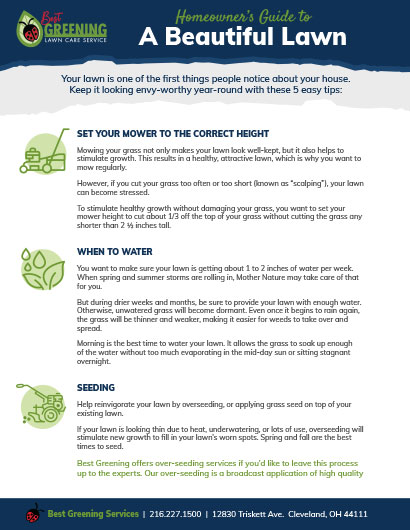Lawn Mowing and the Farmer’s Tan
By Ken Machock
By far, the number one cause of damaged lawns in Northeast Ohio is improper mowing. We survey hundreds, even thousands of lawns over the summer months, with customers who are concerned about the condition of their lawn. Many customers are convinced that it is the cause of an insect, disease, grubs, or even an improper application. But the main cause is right there in the garage . . . the lawnmower.
The damage is commonly referred to as a “hot mow” or “hot mowing.” The damage may appear as obvious marks such as straight lines and usually stops right at the neighbor’s border. Sometimes the damage shows as random patches or blotches that also stop at the neighbor’s lawn or are confined to certain areas in the lawn. In extreme cases, the entire lawn may look this way.
The most common time for hot mow damage to occur is the middle of May through late in June or July. That’s because weather change is a key factor in the cause of the damage. It corresponds with the changing of a cool, wet spring into the dry, hot summer months.
Here’s what happens: each time you mow, you remove the top 20%-30% of the turf blade. This exposes the tender, softer plant tissue that has been protected from the heat and sunlight by the top (removed) portion. A grass plant can consist of 90% water. As summer approaches and the days get longer and hotter, exposing this tender tissue to sudden heat and sunlight that it’s not used to will have the same effect as a severe sun burn.
I personally refer to this as the farmer’s tan effect (and might I add that no one rocks a better farmer’s tan than I do). I often show my customers this effect by exposing my upper arm that reveals a major contrast of nicely tanned forearms, which have been exposed to sunlight, and my tuna-white bicep that would fry to a crisp within 30 minutes of (heaven forbid) removing my shirt.
Typically with turf, this damage is confined only to the grass blades, leaving the roots and stems to regenerate new top growth. Recovery can take a few days or a few months.


